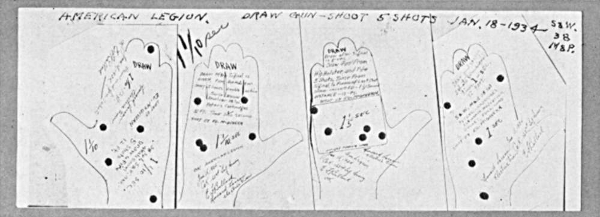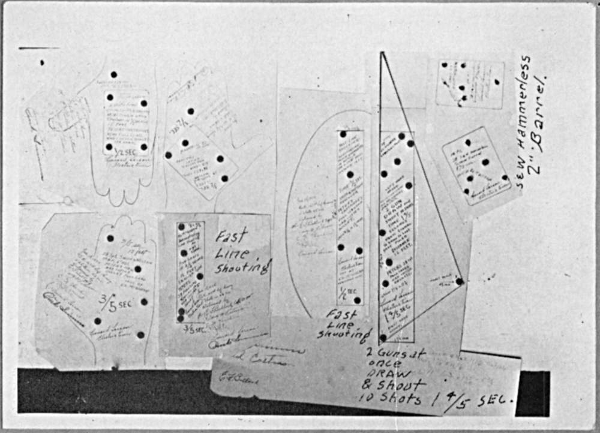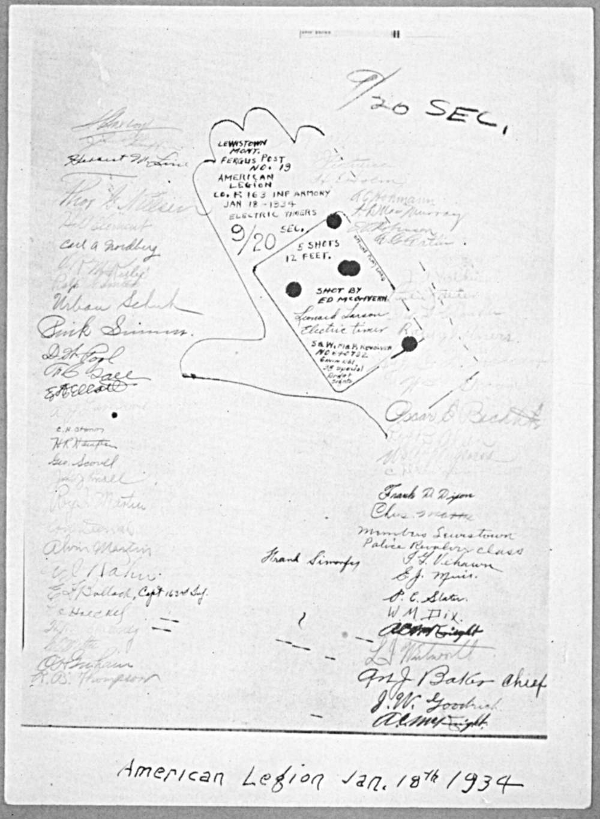The following information about double-action, ultra-speed and flying target shooting with Smith & Revolvers by Ed McGivern comes from Burning Powder. Burning Powder is also available to purchase in print.
For several years interest in rapid-fire shooting has been growing rapidly, and it has remained for Mr. Ed. McGivern of Lewistown, Montana, to develop this form of marksmanship far beyond anything heretofore believed within the scope of human endeavor. With his electric-timing devices checked and approved by experts, his shooting at both stationary and flying targets witnessed and attested by hundreds of disinterested onlookers, Mr. McGivern has time and time again made five hits with a speed that almost defies the ear to distinguish the separate shots.
The revolver with which Mr. McGivern has done the great majority of this ultra-fast shooting is, we are proud to say, one of our .38 S&W Special’s, which left our plant on Sept. 26, 1917, filling a dealer’s order and is, outside of the timing device attached by Mr. McGivern, a standard revolver in every respect.
As the grueling test of the race track pitilessly reveals any inherent weakness of automobile construction or design, so does this ultra-speed firing disclose any fault of the revolver. The Smith & Wesson is the only side-arm Mr. McGivern has found that continues year after year to function at the terrific rate that he demands. The following article by Mr. McGivern, written especially for “Burning Powder,” is worthy of most careful study; following the lines he has here laid out, Mr. McGivern has successfully instructed hundreds of revolver shooters in many police departments throughout the country. His book “Plain and Fancy Revolver Shooting” takes up shooting most thoroughly, and we strongly recommend it to all who are interested in improving their hand-gun shooting.
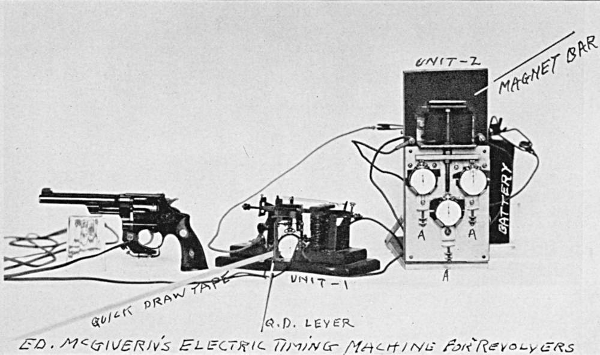
Double-Action, Ultra-Speed and Flying Target Shooting With Revolvers
By Ed McGivern
Since the beginning of time the human race has ever been in quest of speed. This urge for speed down through the ages no doubt brought gradual, but steady, progress and improvement to mankind, ever changing and developing better methods of doing things. Hence travel, transportation and production advanced, until men reached the present stage of “high speed activity” that enters into almost every part of our everyday life, and practically controls our very existence.
Being a genuine Westerner, and hearing so much about the “marvelous speed” and quick action with revolvers of the earlier-day gunmen and “Heroes of the West,” the urge for speed took possession of me. It didn’t take me very far, however, until I found it necessary to study gun construction. In order to get great speed, combined with accuracy, I must find someone who could, and would, construct a better gun mechanism that would be much more dependable than anything I had at hand.
Great speed with such revolver mechanism as I could then secure through the regular channels, was out of the question. Great speed having never been made with such mechanism as I had at hand was, in my mind, out of the question. Speed with accuracy seemed still further out of the question. Speed of any kind without accuracy was absolutely worthless for my purpose. I am perfectly candid; in my opinion it is worthless for any purpose.
By the gentle process of elimination I finally arrived at the point where I confined my “high speed with accuracy” efforts to Smith & Wesson double-action revolvers in the various calibers. I use them as now turned out, from K-.22 to .45 caliber inclusive.
There is nothing mysterious about shooting fast and still hitting objects, if the following points are kept in mind. Practice with the fixed purpose in mind of—always—getting a line shot. A perfect line shot is the most important point to master in “extra rapid fire.” Try for “sure hits” on fair sized targets, at short ranges first, add speed of fire gradually, as you learn to control the shots, so that the finished groups will not be too scattered. Control of elevation will come along rather easily in due time, if the line shooting is maintained.
The targets shown on these pages were made by Ed McGivern using his S&W .38 M&P No. 286600. Such speed and accuracy have only been obtained with Smith & Wesson revolvers.
Start with two double-action quick shots, at any object you choose, one shot following the other just as fast as you can control them, then when good control is fairly well established, try three; then, in order to assist the sub-conscious mind to assume control, let one mental impulse direct you to fire two quick shots, then a slight pause, then two more quick shots, pause, then two more. Use the pause to readjust your mind and muscles for the next two shots. If progress is satisfactory, try three quick shots, then two, or, two, then three, etc. Later, five shots, or even six fast shots, can be fired in a string, and still maintain control of where the shots will strike.
This is the foundation for all of the fast and fancy shooting that can be done with revolvers or automatic pistols, and will establish control by the subconscious mind over the shooting muscles, etc. that will enable the shooter to master any combination of shooting stunts, or any combination of flying or stationary targets known to the game, on any exhibition shooter’s program.
On flying targets learn to hit one target tossed in the air—shooting a line shot—on the lower edge of the target. Next, try two targets, or hit one target twice while in the air, then later try two. When you can hit two targets regularly, have your thrower toss two targets, pause, then two more, pause, then two more, making six, in as short a space of time as you feel sure you can handle them. Later, try three, then two, or two, pause, then three etc. As skill is developed, five targets can be thrown at once, or even six at one time, when the pupil feels “chesty” and has confidence enough to try it. Use large enough targets at short distances first, reduce the size—increase the distance—later.
By dividing the shots up in small groups, the subconscious mind gains perfect control of the shooting muscles, pointing, trigger work, recovery from recoil, etc. All will blend later into one continuous set of movements that can be set in motion, or put into action, and carried out to completion—by one mental impulse, or command, from the brain, TO ACT. The pause will be, or at least can be, shortened by persistent practice until the pause will not be noticeable between each “two, and two, and two shots.” Hence comes the ability to fire fast strings of five or six shots and control the grouping to within the outline of a hand, an ordinary playing card, a can in the air, or several flying targets thrown by two throwers, and so on as fancy may direct.
Do not sacrifice accuracy for speed. Work along carefully to combine them, and success will surely reward the effort.
The Double-Action .38 S&W Special Target revolver, with 6-inch barrel, having a gold bead front sight, is the best all-around gun to be had for this work. The McGivern gold bead front sight is, I believe in all modesty, the finest all-around indoor and outdoor sight to be had, and is my standard equipment on all revolvers. The gold bead is smoked when using the revolver for indoor gallery shooting, and wiped clean again for outdoor shooting.
For two-gun, two-handed shooting, follow the same training for each hand separately. Later, when fairly evenly developed, combine the efforts, use both hands, both guns, at the same time. Surprising results can be secured by the double-action method of operating the revolvers in this manner, and training by this system, as results show.
The trigger squeeze for double-action work is very important. It must be done just as carefully and just as smoothly as the carefully controlled trigger squeeze, for the finest accuracy, in slow, deliberate competitive target shooting, only very much faster, of course. Pulling, yanking or jerking the trigger will not bring success. It would be possible to operate the gun that way, but would make it absolutely impossible to place the shots on any certain spot while doing so.
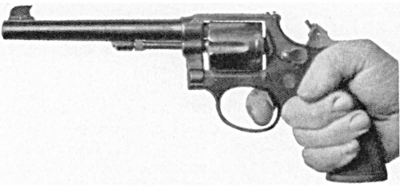
When shooting at moving targets, or at targets tossed in the air (called aerial shooting), this trigger squeezing angle of the game becomes very much more important still. My system of doing it is to hold the grip of the revolver just firmly enough to take up all the slack of the flesh of the hand, evenly, so the hand is not strained or tight in any one part more than in any other, the forefinger placed so it rests just comfortably on the lower part of the trigger. The thumb, as I use it, is resting along the side of the frame of the revolver, the end of thumb is pointing somewhat down towards the trigger finger. As the squeezing pressure is applied, the trigger finger comes back in a direction that, if continued, would bring it just inside of, and just under, the end of the thumb—similar to the position they would be in if placed around the neck of a milk bottle. When the squeezing pressure is applied in this way, through the hand, it will be found that the trigger finger folds up as described, and operates the double-action mechanism perfectly, smoothly, and can be trained to do it very rapidly, without greatly disturbing the aim at one object, for several shots, or the rapid pointing of the gun at several objects.
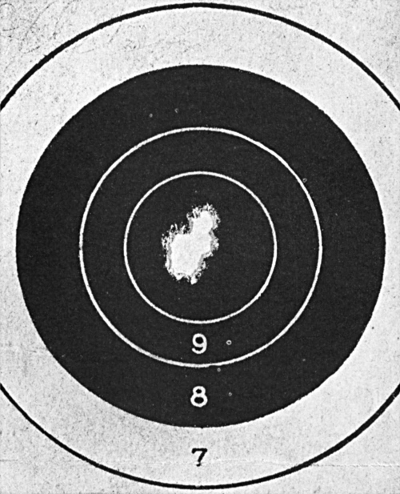
This method of squeezing also steadies the pointing of the gun just at the instant before the hammer falls to fire each shot, and is the real secret that controls the shots, so as to make small groups, and makes it possible to connect with aerial targets under “extreme rapid fire” conditions. Officer Ernie Muir of the Lewistown (Mont.) Police Department, one of my pupils, using this squeezing system, fired 50 consecutive shots, double action, from a Smith & Wesson K-.22 No. 639415, and placed the shots on a target 18 feet distant, making a group of the shots that was completely hidden under a silver quarter. Several of the 10-shot groups could be hidden from view with a dime.
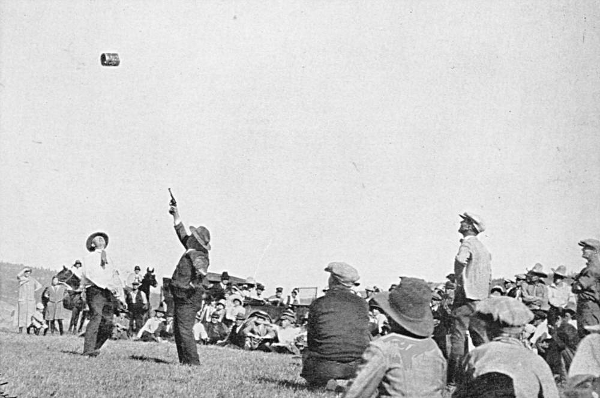
As most aerial targets are shot at while falling, the line shot training suggested is highly important. Learn to use the sights, so as to align them quickly. Keep the point of aim directed at the bottom edge of the target, very similar to the military system of shooting bull’s-eye—by letting them ride on top of your sights—by using your front sight so as to show what is known as a coarse bead, showing above your rear sight notch, your bullets will strike on the target and score a break or hit. When firing several shots at one aerial, or flying target, be sure to keep the revolver pointed at the bottom of the target, as it drops pretty fast and the revolver jumps up from the recoil, making it necessary to point muzzle down again.
The trigger squeeze, line shooting, and muscular control to overcome recoil and get the revolver pointed down again at the bottom of the target to be hit, is the boiled down essence of rapid fire aerial target shooting, and small, fast groups, either with one gun or two. The K-.22 Smith & Wesson revolver is ideal for a training weapon for all of these stunts, as it is, in every way, the equal of any hand gun ever made. Accuracy, speed, and dependable action all combined, these guns, as well as the .38 Special revolvers, are capable of a hand-operated speed of less than 1/2 second for 5 shots by actual test.
Practice with the gun properly aligned with the use of the sights. Becoming thoroughly familiar with the feel of the gun in the hand, when so held, will later enable you to master all the wonderful looking, and much talked about, fancy exhibition stunts, such as shooting from the hip (or near hip level), shooting with the gun held behind the back, quick-draw from holsters, and so on.
The .38/44 Heavy Duty revolver, with 5 inch barrel is, in my opinion, one of the finest, strongest, all-around general purpose guns, studied from all angles, that has ever been given to the shooting public. It is fast—equal to any man’s possible speed. It is sturdy, reliable and, above all, accurate and absolutely dependable in operation. I have given this model of gun the very hardest tests, and failed to balk it in any way.
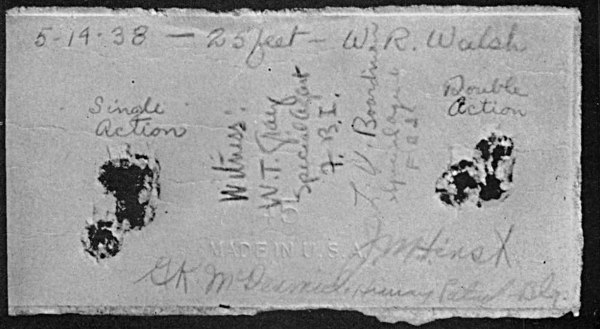
Smith & Wesson has recently brought out the wonderful S&W “.357” Magnum revolver, and for it Winchester Repeating Arms Co. developed the amazingly powerful and accurate S&W “.357” Magnum cartridge. I have tested this arm and ammunition, slow and rapid fire, at ranges from 12 to 15 feet up to 600 yards, and I find it, as issued from the factory with no special work of any kind done to it, the most positive functioning and smoothest operating, as well as the most powerful, accurate and durable revolver ever produced. With the Magnum cartridge its effectiveness is far beyond any other hand-arm and its “impact value” and “killing efficiency” have been so many times demonstrated that I can heartily endorse it as a suitable arm and load for big game hunting when in the hands of a reasonably good revolver shot; for small game and target shooting with the standard .38 S&W Special, or light midrange cartridge, it is a most excellent arm thereby making it the nearest approach to the mythical “all ’round” handgun yet to be produced.
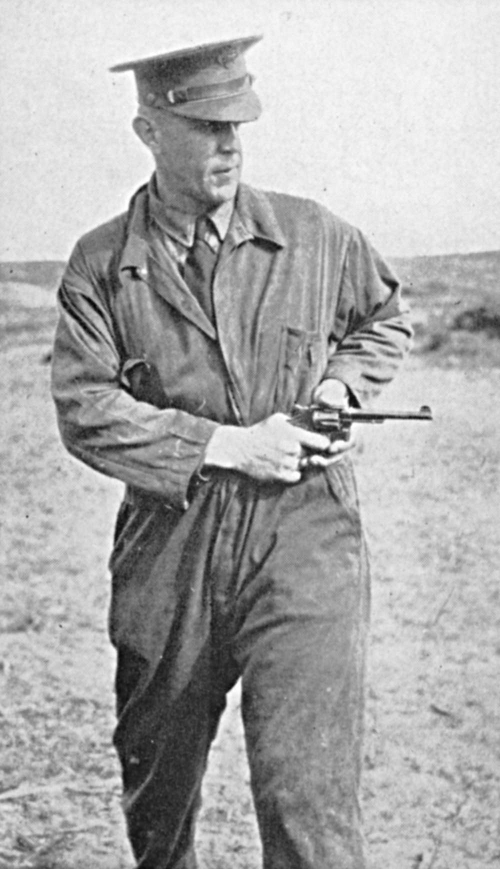
Try rapid fire—high speed—groups, on blank targets at first. Group them from sense of direction around center of target, if possible. Practice will bring success; don’t worry about that. Just shoot, study, keep at it. That’s the key. Take this key, use it, unlock the door to all of this seeming mystery about fast shooting, let in the light. Any average person can learn to do all of these things as outlined.
The S&W K-.22 is an excellent training arm for all of the above outlined training stunts. Swinging targets of medium size are very good training equipment. Langrish man-targets that turn to face you for short periods of time, and then turn edgewise, will develop speed and accuracy. One shot each time, at different circles, is advisable for first trials and this may be worked up to the point where 5-shot strings are fired. This sort of training has been worked out, and has proven very successful in getting results, and will take the big “B” out of “bad man” pretty quickly. The feeling of confidence it builds in an officer, in the handling and use of his revolver, is well worth all the expense and effort required several times over.
I recently returned to the Smith & Wesson factory a K-.22 for a general check-up, feeling that the more than 300,000 rounds of .22 Shorts that had been fired through it might have produced some need of adjustment, but I was convinced by the machine rest groups made by the gun before any work had been done upon it that Smith & Wesson were well justified in their guarantee of the K-.22 against loss of accuracy or malfunctioning for 250,000 rounds when using any suitable .22 ammunition, and with, of course, reasonable care and attention to the arm.
Signed, ED McGIVERN
